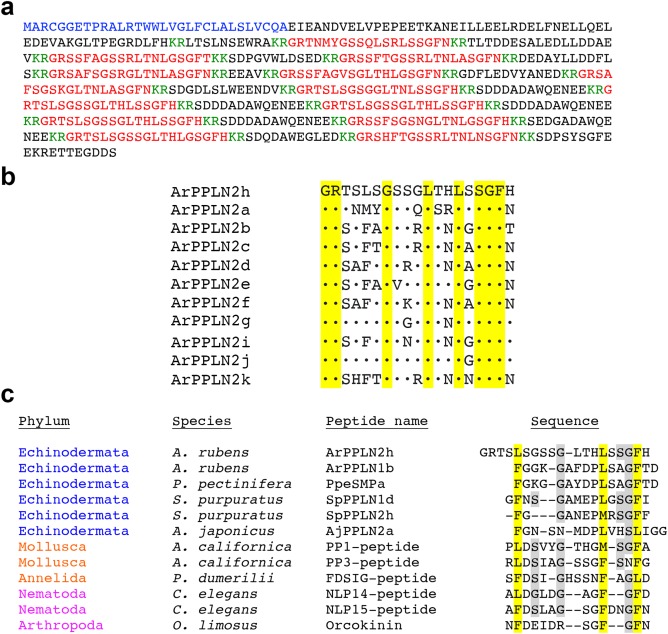Figure 1.

Sequence of ArPPLNP2 and alignments of predicted ArPPLNP2‐derived peptides. (a) Sequence of ArPPLNP2 with the predicted signal peptide marked in blue, predicted cleavage sites marked in green, and peptides ArPPLN2 a to k marked in red. (b) Alignment of ArPPLN2h, which occurs in triplicate in ArPPLNP2, with other peptides derived from ArPPLNP2, which occur singly in ArPPLNP2, as shown in (a). All of the peptides comprise nineteen residues, and residues that are identical to the corresponding residue in ArPPLN2h are shown with a black dot. Eight of the residues in ArPPLN2h are conserved in the ten other peptides (highlighted in yellow). (c) Manual alignment of ArPPLN2h, as a representative ArPPLNP2‐derived peptide, with ArPPLN1b and with PP/OK‐type peptides from other species. Hydrophobic residues (Phe, Leu or Met) are conserved at three positions (highlighted in yellow), one located in the N‐terminal region and two located in the C‐terminal region. Other residues that are conserved between peptides from at least one deuterostome (echinoderm) species and at least one protostome species are highlighted in gray. Citations and/or accession numbers for the peptide sequences included here are as follows: ArPPLN2h (this article; KT601720); ArPPLN1b (Kim et al., 2016; Lin, Egertová et al., 2017; KT870153); PpeSMPa (Kim et al., 2016; KT870152); SpPPLN1d (Rowe & Elphick, 2012; XP_785647); SpPPLN2h (Rowe & Elphick, 2012; XP_003727926); AjPPLN2a (Rowe et al., 2014; Isotig 17873); PP1‐peptide (Lloyd & Connolly, 1989; Moroz et al., 2006; NP_001191585); PP3‐peptide (Moroz et al., 2006; NP_001191625); NLP14‐peptide (Nathoo, Moeller, Westlund, & Hart, 2001; NP_001257067); NLP15 peptide (Nathoo et al., 2001; T20275); OK (Stangier et al., 1992; P37086)
